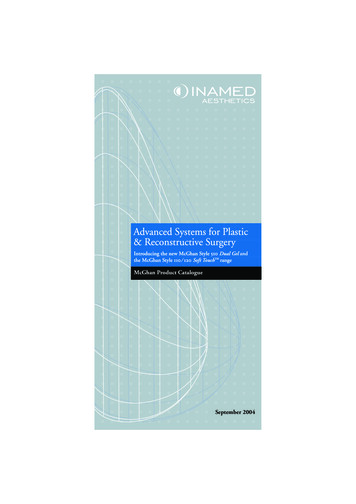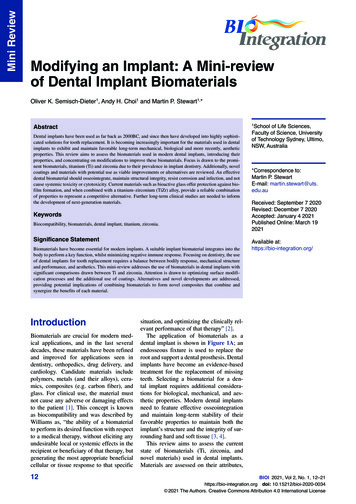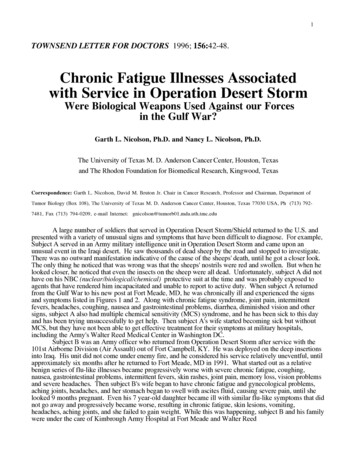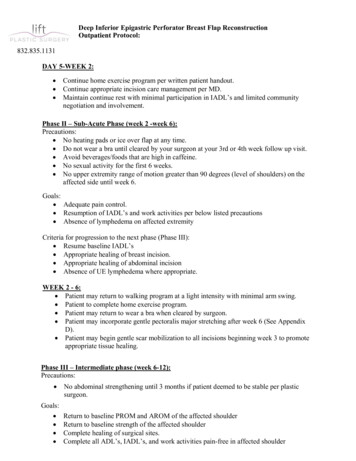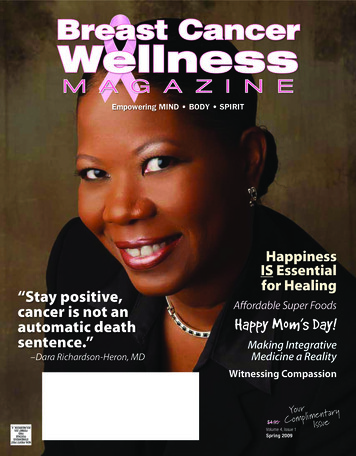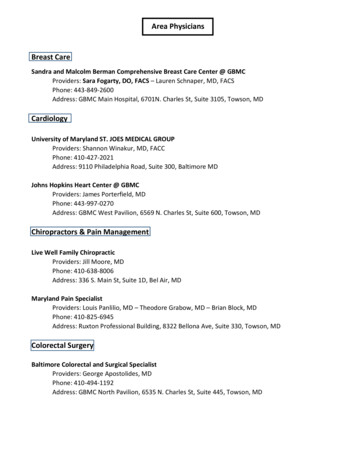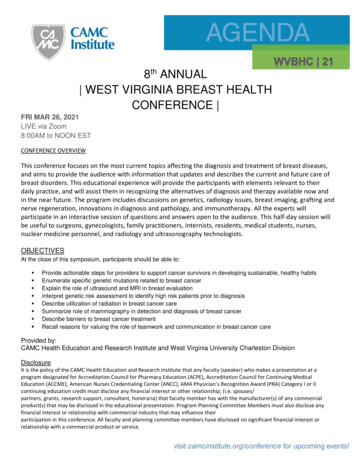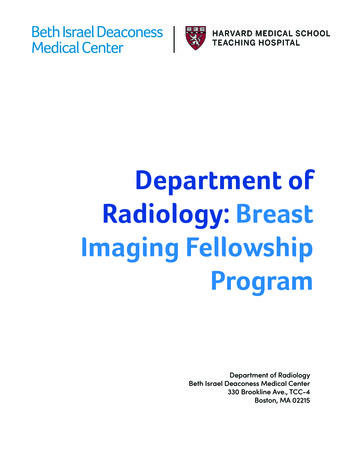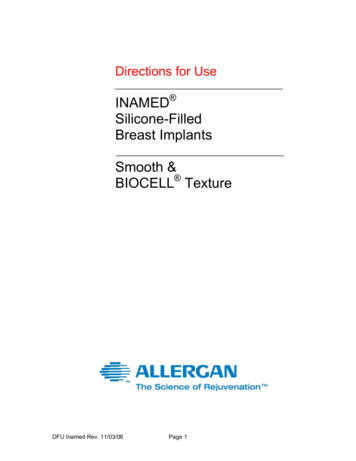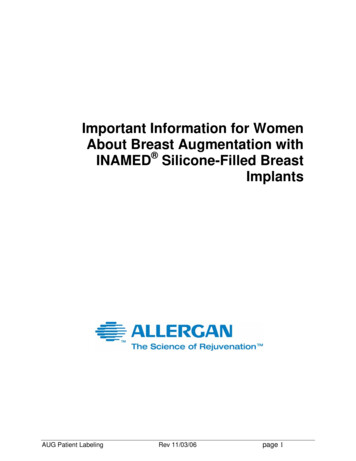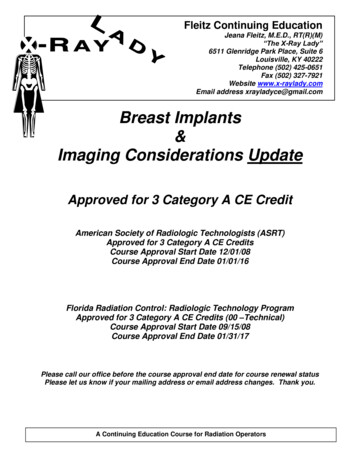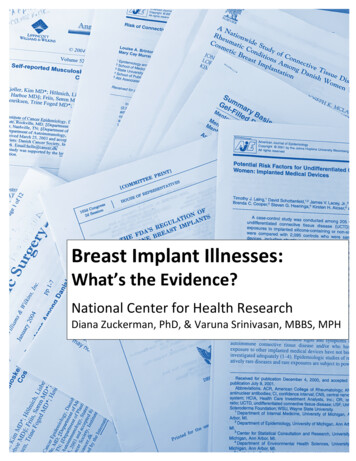
Transcription
Breast Implant Illnesses:What’s the Evidence?National Center for Health ResearchDiana Zuckerman, PhD, & Varuna Srinivasan, MBBS, MPH
Table of ContentsIntroduction . 1Women Requesting Financial Help to Remove Implants. 1The Role of the Food and Drug Administration (FDA) . 2Breast Implant Design Innovations. 6Frequency of Local Complications. 8Cancers, Lymphoma, and Lung Disease . 10The Main Controversy: Autoimmune, Connective Tissue Disease, and Breast Implant Illness . 10Does Research Prove that Breast Implants Don’t Cause These Diseases? . 13Cohort Studies in the Meta-Analysis. 17Case-Control or Cross-Sectional Studies in the Meta-Analysis.21Additional Studies in the IOM Report . 25Conclusions . 32References . 33Page 1 of 41
Breast Implant Illnesses: What’s the Evidence?IntroductionMore than 400,000 women and teenagers undergo breast implant augmentation surgeriesevery year, with 75% for augmentation of healthy breasts and 25% for reconstruction aftermastectomy.1 The popularity of breast implants has risen dramatically in the last 20 years andhas more than tripled since 1997.2 The increase in breast implant surgery, however, does notnecessarily reflect a similarly dramatic increase in the number of women with breastimplants. Many women who undergo surgery are replacing old implants that have broken orcaused problems, and those replacements can occur every 10-15 years or more.Debate swirls over the risks of breast implants, and physicians and patients arejustifiably confused by the conflicting information available. As concerns about breast implantsafety die down, new controversies arise. For example, in 2011, the FDA announced that breastimplants might cause a rare type of lymphoma called ALCL, an international scandal revealedthat tens of thousands of breast implants had been made with industrial silicone instead ofmedical grade silicone,3,4 and the FDA issued a report reassuring women that the highcomplication rate for breast implants was no higher than expected. FDA discussion ofcomplications then and now focuses on breast pain or hardness (called capsular contracture),implant rupture, and cosmetic problems in the breast area. The FDA has repeatedly reassuredthe public that studies “do not show evidence that silicone gel-filled breast implants causeconnective tissue disease or reproductive problems”5 and that “the FDA does not have evidencesuggesting breast implants are associated with health conditions such as “chronic fatigue,cognitive issues and muscle pain.”6By 2018, there were more than 50,000 women reporting a range of symptoms they referto as “breast implant illness” on two Facebook pages: Breast Implant Illness and Healing andBreast Implant Victim Advocacy. More than a dozen Administrators and patient advocates fromthese two Facebook pages met with FDA officials in September 2018 to discuss their healthissues and to urge the FDA to do more to require the completion of large, long-term scientificstudies and to better inform women of the health problems experienced by many women as aresult of their breast implants.Women Requesting Financial Help to Remove ImplantsSince 2015, the National Center for Health Research has been contacted by more than4,500 women who had breast implants that they wanted to remove because of rupture, breastpain, or medical symptoms that they believed to be related to their implants. Most of thewomen could not afford explant surgery, and asked for NCHR’s assistance in persuading theirhealth insurance, Medicare, or Medicaid to cover the cost of implant removal withoutreplacement NCHR has a project to assist these women if they have insurance but have haddifficulty getting coverage for explant surgery. Most health insurance policies will cover the1
cost of breast implant removal when it meets the policy’s criteria for medical necessity. Inalmost all cases, medical necessity is defined as a leaking silicone gel breast implant or severecapsular contracture that causes breast hardness and pain. We are not aware of any policies thatwill cover removal due to systemic illnesses caused by implants, such as those described bythousands of women with breast implants. However, in many cases women have systemicillness in addition to having capsular contracture and a leaking silicone gel implant.In November 2018, the Center began a ground-breaking study of more than 300 of thewomen who were able to get their implants removed. The women were asked to list the mostimportant reasons why they wanted to have their implants removed and not replaced. Ourpreliminary analysis indicates that fewer than one-third had ruptured implants, approximatelyone half had breast pain, and 84% cited an array of other health issues that can be categorized asautoimmune or connective tissue symptoms, rather than diagnosed diseases.At the time that their implants were removed, approximately three out of five of thewomen had implants in their body for 10 years or more, and many had these symptoms foryears. After having their implants removed, 89% of the women reported that their symptomsimproved.It is important to note that when implant manufacturers submitted studies to the FDAthat were used as the basis of FDA approval, the companies stated that they intentionallyexcluded women with a history of autoimmune diseases. FDA required that patient bookletsprovided by implant manufacturers must warn about that; For example, Allergan’s bookletstates: “Caution: Notify your doctor if you have any of the following conditions, as the risks ofbreast implant surgery may be higher: “Autoimmune Diseases (for example, lupus andscleroderma).”7 Unfortunately, patients report they are not given the booklets or the warningprior to surgery, the FDA does not include that warning on its website, and in our preliminaryanalysis, 6% of the women in our study reported that they had been diagnosed with anautoimmune disease prior to getting implants.The goal of this report is to consider all the research evidence to determine what isknown and not known about the risks of breast implants, scrutinizing the research that has beenconducted. We will start with a summary of the role of the FDA and the less controversialissues regarding bout complications from breast implants, and then focus on the mostcontroversial issues: The strengths and weaknesses of the key studies that have been repeatedlyquoted as evidence that breast implants do not cause autoimmune or connective tissue healthproblems. We will also use the information gathered in NCHR’s preliminary study of womenwith implant problems to help understand the conflicting evidence of published studies.The Role of the Food and Drug Administration (FDA)Breast implants were first sold in the 1960s, but the FDA did not have the authority toregulate medical devices until 1976. The 1976 law created three categories of medical devicesbased on risk, with Class III defined as high risk. Breast implants were “grandfathered” ontothe market, but by the late 1970’s, many doctors and scientists had expressed concerns aboutPage 2 of 41
their safety.8 In 1978, an FDA Advisory Panel proposed that breast implants be categorized asmoderate-risk Class II devices, which would not require any clinical trials proving safety oreffectiveness for new implants to go on the market. The FDA instead proposed a Class IIIdesignation in 1982, and in 1983 the FDA Advisory Panel unanimously agreed. In 1988, theFDA Advisory Panel met again and an FDA official, Dr. Nirmal Mishra, listed the possiblerisks of breast implants that needed to be studied, including:Ø Capsular contracture (the painful tightening of the scar tissue around the implant)Ø BreakageØ Micro-leakage (sweating or bleeding of silicone outside the shell)Ø Silicone leakage to the lymphatic systemØ Interference with the accuracy of mammographyØ Immune disordersØ CancerThirty years later, these are still the issues of greatest concern, and the incidence of thesecomplications as implants age is still unknown.By 1990, almost one million women had breast implants, even though there were nopublished clinical trials about their safety and the FDA had never approved them. The FDAoversight committee in the House of Representatives, under the Chairmanship of Rep. TedWeiss, held a hearing in December of 1990, pointing out that the only studies implant makershad submitted to the FDA were silicone injections in rats and rabbits, and that the agency hadignored that law requiring them to promulgate a rule requiring that human clinical trial data besubmitted by the breast implant companies to the FDA if the wanted to keep selling theirimplants.8 Scientists testified about their research indicating substantial safety concerns, andpatients testified for and against implants, depending on their personal experiences.In response to Congressional pressure and negative media coverage, the FDA finallyrequired the manufacturers of silicone gel breast implants to submit safety studies in 1991.Studies of saline breast implants were not required at that time. Unfortunately, the studies ofsilicone gel implants that were submitted to the FDA were poorly designed and conducted; forexample, in the McGhan study, two out of three patients were followed for less than threemonths after their surgery, and there were only three breast cancer reconstruction patients.8Early in 1992, internal memoranda dating from 1960-1987 from Dow Corning, the majorbreast implant manufacturer at that time, were publicly released.8 The documents were widelyPage 3 of 41
reported in the media, with quotable quotes such as a marketing representative tellingphysicians “with fingers crossed” that safety studies were underway. Several memorandacomplained that new breast implants were “greasy,” indicating the micro-leakage of intactimplants that the FDA had been concerned about years earlier. Given the poor quality of thestudies submitted to the FDA and the controversy about the internal documents, it is notsurprising that silicone gel breast implants were not approved at that time.Nevertheless, the FDA made sure that breast implants could still be sold in the U.S., byissuing a compassionate need exemption policy on October 23, 1992.8 This policy restrictedsilicone gel implants in the U.S. to women willing to participate in studies, including a large“Adjunct Study” for reconstruction patients and for women who wanted to replace brokenimplants (called “revision” patients). Approximately 1,000 women, including first-timeaugmentation, reconstruction, and implant replacement patients participated in each company’s“Core Study.” It is important to note that the companies defined reconstruction patients toinclude many women who were not mastectomy patients. Women were also “reconstructed” tocorrect “deformities” such as droopy breasts (not uncommon after women have breastfed achild) and “severe” asymmetry; deformities were subjectively defined by the plastic surgeons.Implant manufacturers could have collected and published extensive safety data from thesestudies. Instead, major shortcomings were reported; for example, many patients reported thattheir physicians encouraged them to enroll in the Adjunct study as a way to qualify for siliconegel implants, explaining that they could drop out immediately after surgery. That anecdotalclaim is supported by the large proportion of participants who dropped out between enrollmentand the first follow-up, and even more after that: only 27% of Inamed’s reconstruction patientsand 20% of their revision patients were followed for three years, as were 18% of Mentor’srevision patients and 19% of their reconstruction patients.9 The problem when so many patientsdrop out of studies is that it is impossible to know if the ones that dropped out have better orworse experiences than those in the study. As a result of losing data from approximately threequarters of the women before the study was completed, these Adjunct “studies” did not providemeaningful safety information.After that same 2003 Advisory Panel meeting, the FDA considered the scientific datathat had been provided and decided not to approve Inamed silicone gel breast implants inJanuary 2004.10 At the same time, the FDA issued a new guidance specifying the type ofresearch that manufacturers would need to submit to obtain approval of any breast implants inthe future. A major focus of the guidance document was the need to determine why breastimplants break, how long they last, and the health consequences of broken and leaking implants.In 2005, the FDA held another Advisory Panel meeting to consider new research onsilicone breast implants that had been submitted by two companies, Inamed (now calledAllergan) and Mentor (now a subsidiary of Johnson & Johnson).11 Their studies only followedwomen for three years, which was not responsive to the FDA guidance asking that theydetermine how long implants last or the health consequences of leaking or broken implants.Page 4 of 41
Meanwhile, controversies regarding implant safety continued. In late 2005, the FDAOffice of Criminal Investigation started an investigation of Mentor, interviewing former Mentoremployee about the sale of defective implants by the company. One employee admitted thatexecutives ordered him to destroy documents related to a high rupture rate of Mentor implantsand admitted that some implants were contaminated with fleas.12Despite the short-term studies and the investigation of Mentor, in November 2006 theFDA approved silicone gel breast implants by Mentor and Inamed (now Allergan) as“reasonably safe” for women who are 22 or older. This was the first time that FDA hadapproved silicone gel implants, and because of serious concerns about safety, the FDA requiredeach of the two implant makers continue their 2-3-year studies for a total of 10 years each, andalso start new studies of at least 40,000 women with breast implants for 10 years, in order toprove long-term safety.13 The purpose of these larger, long-term trials was specifically todetermine if there was a statistically significant risk of connective tissue or autoimmunediseases.The required studies were an acknowledgement that previous studies had been too smallor too short-term to determine if implants caused these systemic diseases, as well as todetermine the long-term risk of documented problems such as implant breakage and breast pain.With few exceptions, almost all the published data were studies funded by implant companies,plastic surgeons, or silicone manufacturer Dow Corning. Although the required studies wouldstill be funded by and conducted by the implant companies, the FDA had input into thescientific design of the studies to address the short-comings of previous research.The required studies were conducted, but 5 years after silicone gel implants wereapproved, neither the companies nor the FDA had made any of the results publicly available.Requests from the National Center for Health Research to make the data public received noresponse. At that point, Congresswoman Rosa DeLauro (D-CT), who chaired the FDAAppropriations committee in the House of Representatives, requested that FDA hold a publicmeeting,14 and the FDA did so in August 2011. The data were provided on the FDA web site inJune 2011 and discussed at the August meeting.13 In addition to invited presentations by theimplant companies and FDA officials, several hours were set aside for public comments.The data in the FDA’s June 2011 report and as presented at the public meeting made itclear that most women enrolled in the required 10-year studies had dropped out within just thefirst few years. More than three-quarters of Mentor’s 40,000 patients had dropped out, and atthe meeting it was mentioned that Mentor had provided no stipend or other incentive for thepatients to complete the very lengthy annual surveys describing their health issues. In contrast,Allergan had paid women 20 each to complete very similar questionnaires. Moreover, severalwomen testified at the hearing that they were thrown out of the implant studies when theyreported serious health problems from their breast implants or decided to have their implantsremoved.15 It was impossible to determine how often that happened, but it raised questionsabout the accuracy of the data provided by the companies, as well as the possible reasons whyso many women “dropped out” of the studies. Nevertheless, the FDA did not question thePage 5 of 41
integrity of the data and maintained in their report that silicone implants were safe andeffective.13FDA states on its website that the 10-year studies of 40,000 women that FDA requiredof each of the two implant companies were never completed.16 FDA reports that their AdvisoryPanel that met in 2011 recommended that the 10-year studies be replaced by a systematicliterature review as well as re-designed studies that “have more efficient methodologies toassess rare complications.” On its website, FDA explains that “In response, FDA entered intocollaboration with the American Society of Plastic Surgeons (ASPS), the Plastic SurgeonsFoundation (PSF), breast implant manufacturers and patient advocate groups, to establish theNational Breast Implant Registry (NBIR) and the PROFILE Registry (established to collect dataon potential cases of breast-implant associated anaplastic large cell lymphoma (BIA-ALCL)).Tufts University was tasked with conducting a systematic literature review to look at rareendpoints (listed below) and silicone gel-filled breast implants. Despite the FDA’s descriptionof the panel’s recommendation to replace post-market studies with a research review, the FDA’sown summary of the meeting is completely different, focusing on the need for clinical trials andregistries to answer important safety questions.17Our analysis of the Tufts review is on page 15 of this report. It is important to note thatalthough the FDA claimed they would include “patient advocacy groups,” none of the patientadvocacy groups that were most involved in the FDA’s breast implant hearings were invited toparticipate in the registries or the Advisory Board of the Tufts Systematic literature review. Inaddition to being funded by implant manufacturer through a grant to the Plastic SurgeonsFoundation, the Advisory Board was comprised primarily by plastic surgeons and industryrepresentatives and its only “patient advocate” was head of an organization that had receivedfunding from implant manufacturers.Breast Implant Design InnovationsOne of the difficulties of studying breast implants is that the implants have changed overtime. The 50 -year history of silicone breast implants is a history of trying to reducecomplications, especially common problems such as implant rupture or breast hardness and paincaused by capsular contracture. Although breast implants were not studied in clinical trials forthe first 30 years that they were used, companies introduced design modifications that wereintended to make implants
breast implant manufacturer at that time, were publicly released.8 The documents were widely . Page 4 of 41 reported in the media, with quotable quotes such as a marketing representative telling . that had been provided and decided not to approve Inamed
